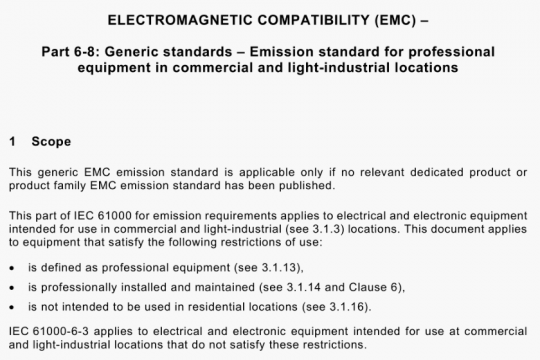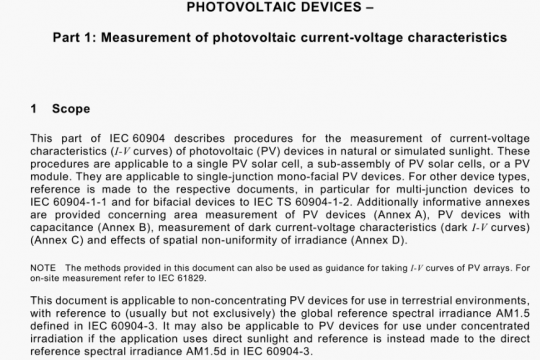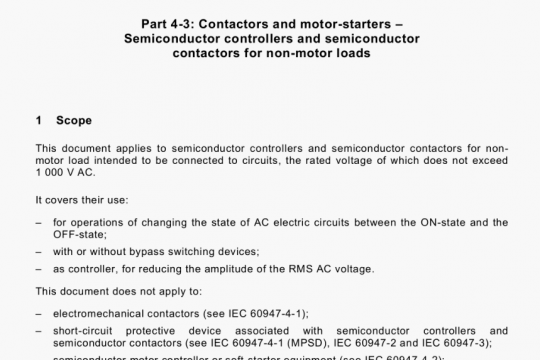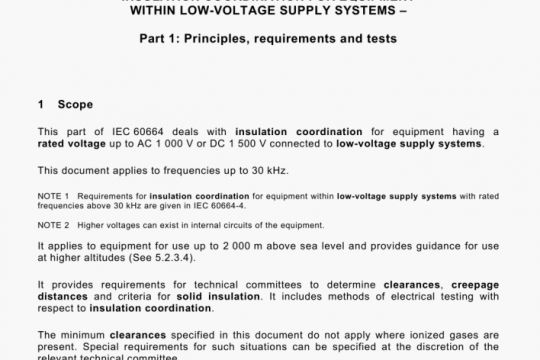IEC TR 63226-2021 pdf free
IEC TR 63226-2021 pdf free.Managing fire risk related to photovoltaic (PV) systems on buildings.
No terms and definitions are listed in this document.
ISO and IEC maintain terminological databases for use in standardization at the following addresses:
• IEC Electropedia: available at http:/Iwww.electropedia .orgi
• ISO Online browsing platform: available at http://www.iso.org/obp
4 Risk evaluation
4.1 General
It is recommended to perform a risk evaluation, to identify, if additional measures are needed and which measures are reasonable in order to reach the intended safety level. Such a site- specific evaluation can help the needs of all stakeholders to be covered without putting unnecessary requirements on all PV systems.
4.2 Site selection
The selection of the site can have a major impact on the recommended measures. The designer should evaluate if the proposed building or part of the building is the best choice for a PV installation. Shifting to another part of the building, to another building or to a ground installation can be a reasonable step to avoid additional measures.
The fire zones and the position of lire protection walls should be evaluated. The PV array should not provide a fire path (bridge) between adjacent fire zones.
4.3 Aspects for building risk evaluation
4.3.1 Roofing materials
Roofing materials have an impact on how much damage an exterior fire will cause to a buitding. In some countries, for example USA, building codes require fire ratings of roofing systems based upon the occupancy of the building. Buildings, where people assemble, such as theatres and churches, require a higher level of roof fire ratings than warehouses. Both are susceptible to exterior fires, but the assembly occupancy has a higher risk to human life and is therefore required to have a more fire-resistant roof.
Roofing materials are tested for certain fire withstand capabilities. However, these product characteristics may not be sufficient to withstand the energy from an arc or fire caused by a fault. If a roofing material is capable of being ignited by an arc or fire caused by a fault, additional measures may be taken into account. Additionally, the presence of PV modules in close proximity to roofing materials may trap or radiate heat from a rooftop fire causing additional roof damage. The higher the fire resistance of the roofing system, the less likely a rooftop fire will cause widespread damage.
Depending on the occupancy of the building and the financial risk of loss for the building, it may be necessary to upgrade a roof system’s fire resistance when a PV system is installed on the roof or use additional measures to reduce the fire risk. If the cost of upgrading the fire resistance of the roof or additional equipment is too high, then other installation locations should be considered that require less investment.
For buildings covered with exposed flammable roofing materials, additional safety measures should be considered to help prevent fire ignition. Flammable roofing materials include many common roofing materials such as bitumen, asphalt, tar paper, and various polystyrene and polyisocyanurate insulating materials. Higher fire-rated roofing systems that incorporate the most flammable polystyrene insulating materials normally include what is referred to as a cover board between the roof membrane and the insulation to prevent a fire on the membrane from involving the flammable polystyrene materials beneath the membrane.
All roofs in Europe — with or without PV — must comply with fire resistance classes according to CENITS 1187. There are four different regions with four different tests within Europe. Generally, the requirements are separated into building-integrated PV (BIPV) where PV modules need to comply with the same requirements as the roof skin and building-applied PV (BAPV) with lower requirements related to fire resistance such as ignitability.
Building products and building materials in Europe are classified according to the EN 13501 series, for example class E. Ignitability (e.g. in Germany for BAPV “normal ignitability” is required by building codes — DlBt) is tested according to ISO 11925 (all parts).
4.3.2 BuIlding construction
Not only is the roof construction important to the fire risk of a building, the entire building construction is also important. Buildings constructed of concrete, brick, and stone are more fire resistant than steel or wood structures. The concern with building construction types may be accelerated building collapse or propagation of fire to adjacent structures.IEC TR 63226 pdf download.




